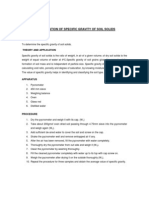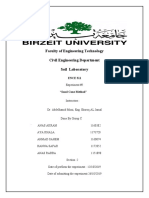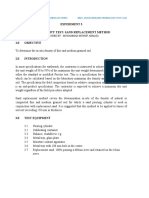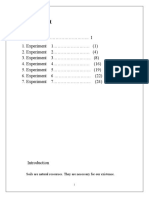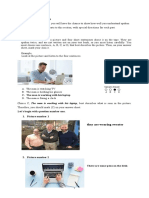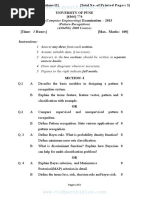Sand Replacement Test
Sand Replacement Test
Uploaded by
liwor34001Copyright:
Available Formats
Sand Replacement Test
Sand Replacement Test
Uploaded by
liwor34001Original Title
Copyright
Available Formats
Share this document
Did you find this document useful?
Is this content inappropriate?
Copyright:
Available Formats
Sand Replacement Test
Sand Replacement Test
Uploaded by
liwor34001Copyright:
Available Formats
INDIAN INSTITUTE OF TECHNOLOGY GANDHINAGAR
Department of Civil Engineering
Soil Mechanics Laboratory
SAND REPLACEMENT (INSITU-DENSITY) METHOD
(IS 2720-PART-28-1974) Reaffirmed-2010
THEORY:
Sand replacement method is used to determine the in-situ density of soil. The in-situ density is defined as the
density of soil measured at its actual depth on the field. The in-situ moisture content of soil varies with time, resulting in
variable in-situ bulk density. To avoid variation with time, the in-situ density should be reported in terms of the dry
density with moisture content.
NEED & SCOPE:
In-situ density of the soil is needed for the determination of following:
• Bearing capacity of soils
• Stability analysis of slopes and earth retaining structures
• Determination of pressures on underlying strata for the calculation of settlement and the design of underground
structures
Where soil compaction is required (projects like embankment and earth dam construction), sand replacement method can
be used as a quality control test to evaluate the degree of compaction.
APPARATUS REQUIRED:
1. Sand pouring apparatus
2. Calibration cylinder
3. Glass plate
4. Vernier calliper
5. Standard sand-graded between 300 micron and 600 micron
6. Soil tray with a central hole
7. Digging tools like chisels
8. Balance of 20 kg capacity
9. Containers for moisture content determination
10. Sensitive balance accurate to 0.01gm
11. Oven controlled at 105˚ C
PROCEDURE:
Weight of Sand Occupying the Cone of the Sand Pouring Apparatus
1. Pour sand into the sand pouring apparatus with valve closed and determine weight of apparatus filled with sand
(W1).
2. Place the apparatus on a smooth glass plate and open the valve to fill the conical portion. After the sand stops
running from apparatus, close the valve sharply, and weight the remaining sand with the apparatus (W2).
3. The weight (W1 – W2) represents the weight of sand required to fill the cone of the apparatus.
IIT Gandhinagar, Soil Mechanics Lab Page1
INDIAN INSTITUTE OF TECHNOLOGY GANDHINAGAR
Department of Civil Engineering
Soil Mechanics Laboratory
Density of Sand
1. Fill the Sand Pouring Apparatus again with valve closed and determine weight of apparatus filled with sand (W3).
2. Place the sand pouring apparatus concentrically on top of the calibrating cylinder. Open the shutter and allow the
sand to drain out. When no further movement of sand takes place in the apparatus, close the shutter and weight
the apparatus with remaining sand (W4).
3. The weight (W3-W4) represents the quantity of sand used in filling calibrating cylinder as well as cone of the
apparatus.
4. Weight of sand required to fill the calibrating cylinder can be calculated as [(W3-W4) – (W1 – W2)].
5. Volume (Vc) of the cylinder may be determined either by measuring its internal dimensions or by filling it with
water and determining the volume of water required to fill the cylinder.
6. Density of sand can be computed using mass of sand filled in cylinder and volume (Vc ) of the cylinder.
Density of Soil
1. Prepare the surface of the location to be tested so that it is a level plane. Keep the soil tray firmly on the surface.
2. Excavate with hand tools a hole with diameter equal to that of the hole of the plate and about 10 cm in depth with
smooth walls and rounded bottom edges.
3. Place the extracted soil from hole in a container being careful to avoid losing any material and determine the
weight of extracted soil.
4. Place the already weighed sand pouring apparatus filled with sand (W5) on the hole of the tray. Open the valve
and after the sand has stopped flowing close the valve.
5. Weigh the apparatus with remaining sand (W6) and determine the weight of sand occupying the cavity [(W6-W5)
- (W1-W2)].
6. Take three representative sample from the extracted soil for moisture content determination.
OBSERVATIONS & RECORDINGS:
From the known density of sand and the weight of sand occupying the hole, calculate the volume of hole.
From the weight of the soil scooped out of hole whose volume is now known and the value of moisture content, calculate
the wet and dry density of soil.
Dimensions of Calibration Cylinder
Internal diameter of calibration cylinder = cm
Height of calibration cylinder = cm
Volume of calibration cylinder from the dimensions = cc
Volume of calibration cylinder from the weight of filled water = cc
IIT Gandhinagar, Soil Mechanics Lab Page2
INDIAN INSTITUTE OF TECHNOLOGY GANDHINAGAR
Department of Civil Engineering
Soil Mechanics Laboratory
I) DENSITY OF STANDARD SAND
a) Sand Occupying Cone
Weight of sand pouring cylinder + sand before opening shutter (Glass Plate) (W1)
Weight of sand pouring cylinder + sand after opening shutter (Glass Plate) (W2)
Weight of sand in cone (W1-W2)
b) Sand Occupying Calibrating Cylinder
Weight of sand pouring cylinder + sand before opening shutter (W3)
Weight of sand pouring cylinder + sand after opening shutter (W4)
Weight of sand in Calibrating Cylinder Wc= (W3-W4) – (W1 – W2)
Density of the standard sand γs = Wc/Vc
=
II) In-situ Density using Sand Replacement Method:
No. Particulars
1. Bulk density of standard sand, γs (gm/cc)
2. Weight of sand pouring apparatus +sand before experiment (W5), gm
3. Weight of sand pouring apparatus + sand after experiment (W6), gm
4. Weight of sand drained out (W6-W5), gm
5. Weight of sand occupying cone (W1-W2), gm
6. Weight of sand occupying cavity [Ws= (W6-W5) – (W1-W2)], gm
7. Volume of cavity (V= Ws/ γs ), cc
8. Weight of soil scooped out from the cavity (W), gm
9. Bulk density (γt = W/V), gm/cc
10. Moisture content, w%
11. Dry density, [γd = γt /(1+w)], (gm/cc)
Moisture Content Percent:
IIT Gandhinagar, Soil Mechanics Lab Page3
INDIAN INSTITUTE OF TECHNOLOGY GANDHINAGAR
Department of Civil Engineering
Soil Mechanics Laboratory
CONTAINER No.
Wt. of container, Wt (gm)
Wt. of container + Wet soil, Ww (gm)
Wt. of container + Dry soil , Wd (gm)
Wt. of water, Ww-Wd (gm)
Wt. of dry soil, Wd-Wt (gm)
Moisture content, w % = (Ww-Wd / Wd-Wt) * 100
Average moisture content, w%
• Average Moisture Content of the Soil Layer = %
• Average Dry Density of the Soil Layer = gm/cc
IIT Gandhinagar, Soil Mechanics Lab Page4
You might also like
- Sample Report For CFA in APADocument6 pagesSample Report For CFA in APANasir Jan Kakar100% (1)
- Case Study Seiko InstrumentsDocument15 pagesCase Study Seiko Instrumentsnayandumgt100% (5)
- Lab Report Sand Replacement MethodDocument9 pagesLab Report Sand Replacement MethodNasrul100% (1)
- Field Dry Density Test Using Sand Replacement MethodDocument29 pagesField Dry Density Test Using Sand Replacement MethodJassel Jalandoni100% (1)
- Field Density Test PDFDocument3 pagesField Density Test PDFEngr. Mahmud100% (1)
- Mental Alchemy How To Attract Any Amount of MoneyDocument24 pagesMental Alchemy How To Attract Any Amount of MoneyTamajong Tamajong Philip100% (8)
- Process Description DmeDocument3 pagesProcess Description DmeFirdaus YahyaNo ratings yet
- Field Density by Sand Replacement MethodDocument4 pagesField Density by Sand Replacement MethodNarender CivilNo ratings yet
- SAND REPLACEMENT TEST Lab Manual PDFDocument3 pagesSAND REPLACEMENT TEST Lab Manual PDFRobinson Tara TangkesaluNo ratings yet
- Sand Replacement Test Lab ManualDocument3 pagesSand Replacement Test Lab Manualmm100% (1)
- Soil Compaction Test: Insitu Density Test Using Sand Cone Replacement MethodDocument3 pagesSoil Compaction Test: Insitu Density Test Using Sand Cone Replacement MethodHu DaNo ratings yet
- Field Density Test: Sand Replacement Method ObjectiveDocument5 pagesField Density Test: Sand Replacement Method ObjectiveTsihatesfaNo ratings yet
- EXPERIMENT 8 Field Density of Soil Using Sand Cone Method 3.4.2018Document14 pagesEXPERIMENT 8 Field Density of Soil Using Sand Cone Method 3.4.2018jonilyn florentinoNo ratings yet
- 2018UGCE025(GEO_EXP3)Document10 pages2018UGCE025(GEO_EXP3)ssc22kNo ratings yet
- Insitu Density TestsDocument9 pagesInsitu Density TestsIsuru Udayanga NanayakkaraNo ratings yet
- Field Density Test by Sand Replacement MethodDocument4 pagesField Density Test by Sand Replacement Methodibrih wazirNo ratings yet
- Determination of In-Situ Unit Weight of Soil: Experiment No 2 & 3 Soil Mechanics Laboratory CE PC 594Document30 pagesDetermination of In-Situ Unit Weight of Soil: Experiment No 2 & 3 Soil Mechanics Laboratory CE PC 594SumanHaldar100% (1)
- Experiment 7: Field Density (Sand Cone Method)Document8 pagesExperiment 7: Field Density (Sand Cone Method)Thanaa' Marabeh100% (1)
- Core Cutter TestDocument3 pagesCore Cutter TestManish AryaNo ratings yet
- Field Density Test: Sand Replacement MethodDocument5 pagesField Density Test: Sand Replacement MethodGayathri RSNo ratings yet
- ReportDocument11 pagesReportAbdul latif Abdul latifNo ratings yet
- Determination of Field Density of Soil by Sand Replacement MethodDocument8 pagesDetermination of Field Density of Soil by Sand Replacement Methodabhishek negiNo ratings yet
- Field Compaction TestsDocument6 pagesField Compaction TestsRapolu VyshnaviNo ratings yet
- Lab Report-Sand Replacement MethodDocument9 pagesLab Report-Sand Replacement MethodOchini Chandrasena56% (9)
- Soil Lab ManualDocument39 pagesSoil Lab ManualHuy PanhaNo ratings yet
- Sand Replacement TestDocument6 pagesSand Replacement Testcinterrrtotebags0% (1)
- CE2308 Lab Manual PDFDocument40 pagesCE2308 Lab Manual PDFPeter SingletonNo ratings yet
- Faculty of Engineering Technology Civil Engineering Department Soil LaboratoryDocument11 pagesFaculty of Engineering Technology Civil Engineering Department Soil LaboratoryAnas Abu-shawishNo ratings yet
- In-Situ Density (Sand Replacement) Test: Core Cutter MethodDocument4 pagesIn-Situ Density (Sand Replacement) Test: Core Cutter Methodetec1500m200112No ratings yet
- Title and Number of The Laboratory ExperimentDocument5 pagesTitle and Number of The Laboratory ExperimentNicole Angela MadeloNo ratings yet
- Sand Corn TestDocument6 pagesSand Corn TestTinaaTiny100% (1)
- Field Density Test: A. Calibration of Mechanical DeviceDocument11 pagesField Density Test: A. Calibration of Mechanical DeviceAnn Bernadette PenaflorNo ratings yet
- Geo report 2Document8 pagesGeo report 2Adi haziqNo ratings yet
- 9-In Situ Density by Core Cutter&Sand Repl - MTHDDocument4 pages9-In Situ Density by Core Cutter&Sand Repl - MTHDmuhammad irfanNo ratings yet
- Sand Replacement Method.Document3 pagesSand Replacement Method.stormchaser01No ratings yet
- Sop PrintDocument17 pagesSop Printsubhajith107No ratings yet
- Sand Cone Test PDFDocument11 pagesSand Cone Test PDFDinush SenanayakeNo ratings yet
- Experiment 3 Field Density Test: Sand Replacement Method: (Prepared By: Muhammad Munsif Ahmad)Document5 pagesExperiment 3 Field Density Test: Sand Replacement Method: (Prepared By: Muhammad Munsif Ahmad)Hidayat AzisNo ratings yet
- Field Density - Sand ReplacementDocument2 pagesField Density - Sand ReplacementkandepigopiNo ratings yet
- Soil Mechanics Lab ManualDocument39 pagesSoil Mechanics Lab ManualDharmaraaj RajalinggamNo ratings yet
- Geotechnical Engineering Laboratory ManualDocument65 pagesGeotechnical Engineering Laboratory Manualnitin anantNo ratings yet
- Field Density T-WPS OfficeDocument15 pagesField Density T-WPS OfficeNICKSON KIPKURUINo ratings yet
- Sand Replacement MethodDocument19 pagesSand Replacement MethodMazliah Zainal Abidin100% (1)
- Compaction Control Test OR Determination of Field Unit Weight of CompactionDocument11 pagesCompaction Control Test OR Determination of Field Unit Weight of CompactionMusfiqur RahmanNo ratings yet
- ProblemsDocument20 pagesProblemsRenjith S AnandNo ratings yet
- Geotechnical Laboratory Manual-IIDocument124 pagesGeotechnical Laboratory Manual-IIMir100% (6)
- Determination of Field Density of Soil by Sand Replacement MethodDocument3 pagesDetermination of Field Density of Soil by Sand Replacement MethodAkash SahuNo ratings yet
- Lab Manual 6 and 7Document8 pagesLab Manual 6 and 7Prabesh PokharelNo ratings yet
- Sand Cone TestDocument6 pagesSand Cone TestOl SreylinNo ratings yet
- Field Density by Core Cutter MethodDocument3 pagesField Density by Core Cutter MethodNarender CivilNo ratings yet
- Quality Control TestsDocument22 pagesQuality Control Testsvarma369vinaNo ratings yet
- Ce-481 Soil Mechanics II CompactionDocument36 pagesCe-481 Soil Mechanics II Compactiondaniel bulNo ratings yet
- Table Content: Soils Are Natural Resources. They Are Necessary For Our ExistenceDocument35 pagesTable Content: Soils Are Natural Resources. They Are Necessary For Our Existenceእንቁ ኤልሞNo ratings yet
- Lab ReportDocument39 pagesLab ReporthaftamuTekleNo ratings yet
- FIELD DENSITY TEST CommentaryDocument3 pagesFIELD DENSITY TEST CommentaryAstray NoirNo ratings yet
- Field Density (1)Document17 pagesField Density (1)charitymnebranNo ratings yet
- Laboratory Sand Cone TestDocument12 pagesLaboratory Sand Cone TestScribdTranslationsNo ratings yet
- Experiment 13Document11 pagesExperiment 13ap.allenjairus.torreNo ratings yet
- New GT Lab PDFDocument56 pagesNew GT Lab PDFDIVYA NATHNo ratings yet
- Mahmood Younis M.Ali 2. Muhammed Abs M.Ali 3. Zaytun Ihsan 4. Veyan Ismail 5. HannaDocument6 pagesMahmood Younis M.Ali 2. Muhammed Abs M.Ali 3. Zaytun Ihsan 4. Veyan Ismail 5. HannaM ZanganaNo ratings yet
- Sand Control and Gravel Packing Techniques: It Never Rains in the Oil Field!From EverandSand Control and Gravel Packing Techniques: It Never Rains in the Oil Field!Rating: 5 out of 5 stars5/5 (1)
- Case Studies in Fluid Mechanics with Sensitivities to Governing VariablesFrom EverandCase Studies in Fluid Mechanics with Sensitivities to Governing VariablesNo ratings yet
- Money Mindset University WorkbookDocument56 pagesMoney Mindset University WorkbookMiguel BerrunNo ratings yet
- 21st Century Learning: Research, Innovation and PolicyDocument13 pages21st Century Learning: Research, Innovation and PolicyHeka Arcana PutraNo ratings yet
- English 115 Reflective EssayDocument3 pagesEnglish 115 Reflective Essayapi-490197219No ratings yet
- History of ManagementDocument18 pagesHistory of Managementdob14No ratings yet
- Scrivener 2.8 For MacOS - LiteratureDocument554 pagesScrivener 2.8 For MacOS - LiteratureSarazeen Saif AhanaNo ratings yet
- Solid Waste Management Made Easy (By DENR and ESWM Fieldbook)Document45 pagesSolid Waste Management Made Easy (By DENR and ESWM Fieldbook)AlvinMatabang100% (2)
- Guides To The Freshwater Invertebrates of Southern Africa Volume 2 - Crustacea IDocument136 pagesGuides To The Freshwater Invertebrates of Southern Africa Volume 2 - Crustacea IdaggaboomNo ratings yet
- Dual SlopeDocument3 pagesDual SlopeDilip Kumar100% (1)
- Science Qar TemplateDocument47 pagesScience Qar TemplateMarie Dinalo AbrasaldoNo ratings yet
- Daily Lesson LOG: School Grade Level Teacher Learning Area Teaching Dates and Time QuarterDocument5 pagesDaily Lesson LOG: School Grade Level Teacher Learning Area Teaching Dates and Time QuarterArlynn Arcaño IslaNo ratings yet
- Flow Properties and Design Procedures For Coal Storage Bins PDFDocument401 pagesFlow Properties and Design Procedures For Coal Storage Bins PDFEmaVanni100% (2)
- Drill and Blast ModuleDocument5 pagesDrill and Blast ModuleRCBNo ratings yet
- Mathematics P1 Feb-March 2014 Memo Afr & EngDocument17 pagesMathematics P1 Feb-March 2014 Memo Afr & Engaleck mthethwaNo ratings yet
- Concentrations in Beef and Lamb of Taurine, Carnosine, Coenzyme Q10, and CreatineDocument9 pagesConcentrations in Beef and Lamb of Taurine, Carnosine, Coenzyme Q10, and CreatineksksoskNo ratings yet
- Listening Usbk 22Document4 pagesListening Usbk 22Nylla Desy SaputriNo ratings yet
- EMPA 113 - Assignment IDocument5 pagesEMPA 113 - Assignment IKNo ratings yet
- Tardiness in Relation To The Academic PeDocument12 pagesTardiness in Relation To The Academic PeKunal Sajnani100% (1)
- Pattern RecognitionDocument3 pagesPattern RecognitionANiketNo ratings yet
- Feedback Final Quiz 1 Attempt ReviewDocument4 pagesFeedback Final Quiz 1 Attempt Reviewanembam putobungbong100% (1)
- Sixth Sense Robotics Workshop ProposalDocument12 pagesSixth Sense Robotics Workshop ProposalMayur Dev Sewak100% (1)
- Hybrid LayerDocument11 pagesHybrid LayerRogo CatalinNo ratings yet
- 2.1.6 project majority vote -1 (1)Document13 pages2.1.6 project majority vote -1 (1)Haejoon OhNo ratings yet
- Law Enforcement Administration: De-BriefingDocument14 pagesLaw Enforcement Administration: De-BriefingLlevon Buna100% (1)
- MATHDocument6 pagesMATHDonna Mendoza ComiaNo ratings yet
- Labor Productivity and AnalysisDocument27 pagesLabor Productivity and AnalysisBasit AnwarNo ratings yet
- Pde BookDocument295 pagesPde BookAshenafiNo ratings yet
























